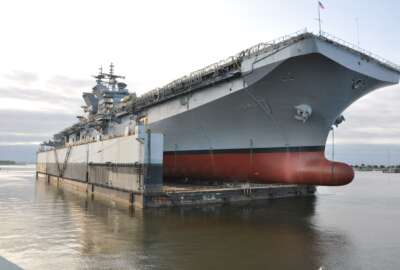
Navy: money, workforce growth alone won’t fix ship maintenance problems
The Navy’s 2018 budget request includes a billion more dollars and a thousand new employees to help the service dig out of an ongoing ship maintenance backlog.
The Navy’s 2018 budget request includes a billion more dollars and a thousand new employees to help the service dig out of an ongoing ship maintenance backlog. Trouble is, the Navy’s current training regimen for new depot maintenance workers takes about five years before they’re ready to work, and officials say they need to find ways to speed that process up.
The Navy’s focus on maintenance is part of a broader plan to increase the readiness of the force in 2018 before it releases plans to begin building up the size of the fleet in 2019.
The workforce growth at the Navy’s four public shipyards would continue a hiring trend that began in 2017. By the end of next year, the service plans to increase its depot maintenance staff from 33,850 to 34,988, and eventually to 36,100 over the next few years.
Vice Adm. Thomas Moore, the commander of Naval Sea Systems Command said the 2018 maintenance budget – $9.7 billion – is an unprecedented amount, and although he welcomes it, money alone won’t solve the Navy’s maintenance challenges. He said the public shipyards’ workforce needs to get more efficient, and new hires need to be able to get to the point where they can perform productive work more quickly than they can today.
“We need to cut our training time back,” he said last week at a forum hosted by the Center for Strategic and International Studies. “With new training methods that are available today, we’re looking to get people to the point where they can turn a wrench and do something useful on our ships in two to three years versus five years. We’re going to have to think differently about how we train the young men and women coming in today, because they learn differently than we do.”
Likewise, Moore said the Navy needs to make sustained investments in its public yards and maintenance facilities, many of which are more than 100 years old and are showing their age. In addition to needing new welding equipment and IT systems, they also need to be physically expanded, since many of their docks are too small to handle the largest variant of the Virginia Class submarine and the new Ford Class aircraft carrier.
He said the private shipyards the Navy contracts with for some of its maintenance needs have done a good job of keeping their facilities in modern condition, but that’s been less true on the government side.
“Typically, we make capital investments in the yard on the order of 20-25 years. The industry standard is about 15 years less than that,” he said. “I don’t have the same business model since I’m not out to make a profit, but I need the same type of incentive. To me, the investment means I get more productive and therefore I spend less maintenance dollars in the future so there’s more money available for procurement.”
As one way to lay the groundwork for those future investments in public shipyards, the Navy has ordered a thorough examination of the workflows at all of its public yards with an eye toward increasing their productivity, including the layout of each maintenance shop and the amount of time employees have to spend in a given workday walking back and forth between work stations.
Although the Navy is predominantly focused on maintenance and other readiness activities rather than shipbuilding in 2018, Moore argued that keeping the existing fleet in good condition is the fastest way to achieve its plan for a 355-ship fleet.
The service’s current projections show that based on the capacity of the defense industrial base, it would take until 2045 to build enough new ships to reach 355 hulls. But the Navy could get a fleet of that size 10-15 years sooner if it simply kept more of its existing ships in service for longer periods. Moore said the Navy is already exploring ways to extend the lives of its cruisers, destroyers and amphibious ships.
“We’re taking a pretty close look at what it would take to keep them for another five or ten years, and the reality is that if you do the maintenance, with today’s open architectures, there’s great opportunities to make a relatively small investment to keep ships around longer,” he said. “People will say to me that we’ve really never kept a surface ship past 35 to 40 years, and I point out that we routinely take aircraft carriers out to 50 years. The reason is that we consistently do all of the maintenance we have to do on aircraft carriers. So we know how to do this.”
But the Navy hasn’t always done it. For most of the decade of the 2000s, it dramatically scaled back its attention to ship maintenance, part of the reason it’s facing the backlog that exists today.
“When I first became a flag officer in 2008 we had kind of reached an epiphany where we woke up one morning and realized, ‘Oh my goodness, we’re failing all of these [inspections] and we don’t have ships that can get out to their expected service lives.’ We had gone along happily for about ten years thinking we could save money on maintenance and spend it on other things,” Moore said. “The reality is we were consuming the redundancy that was built into the ships, and eventually it caught up to us. We’ve spent the better part of the last eight or nine years digging ourselves out of that hole.”
But the problem is far from gone, and it’s most acute with regard to the Navy’s nuclear-powered aircraft carriers and submarines. Only about one-third of those vessels make it in and out of shipyards for their scheduled maintenance availabilities on time, a problem Moore says is his top priority.
Return to DoD Reporter’s Notebook
Copyright © 2024 Federal News Network. All rights reserved. This website is not intended for users located within the European Economic Area.
Jared Serbu is deputy editor of Federal News Network and reports on the Defense Department’s contracting, legislative, workforce and IT issues.
Follow @jserbuWFED





